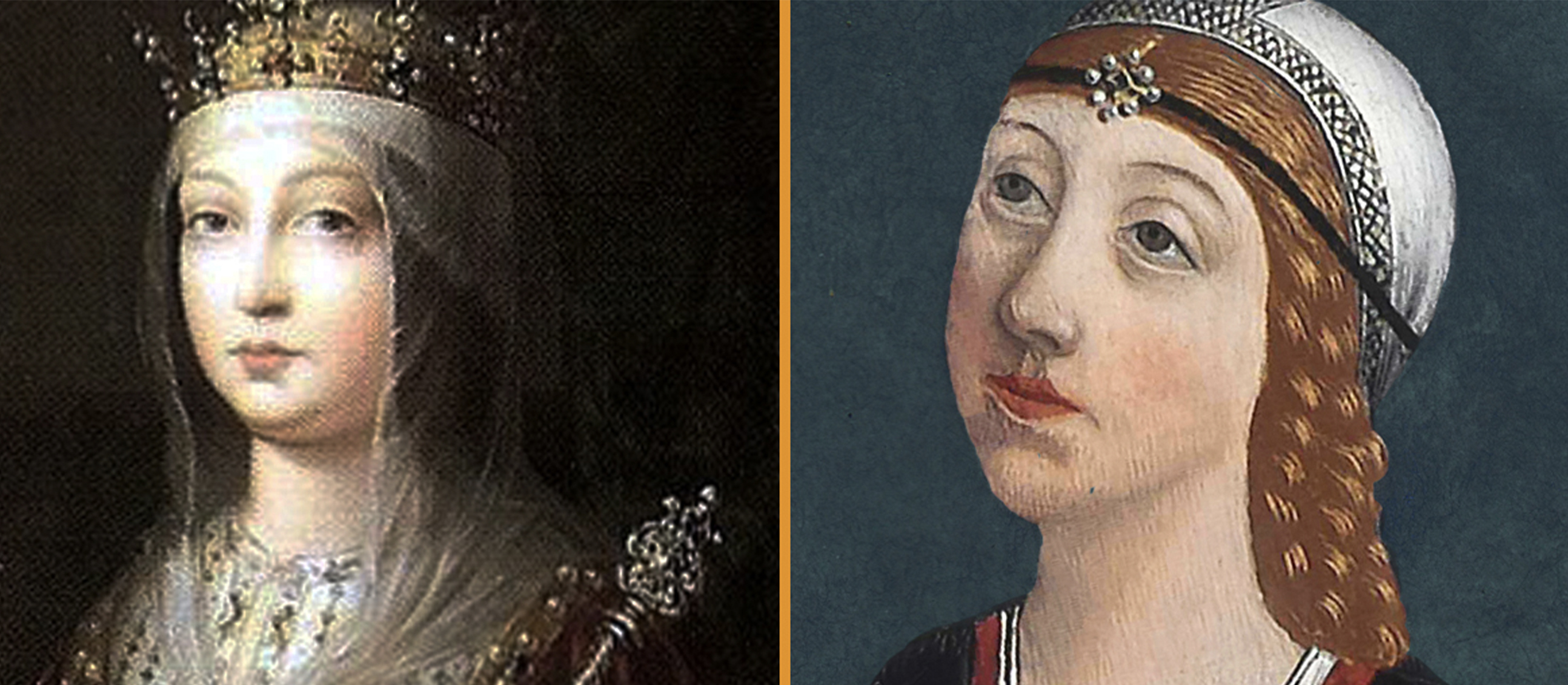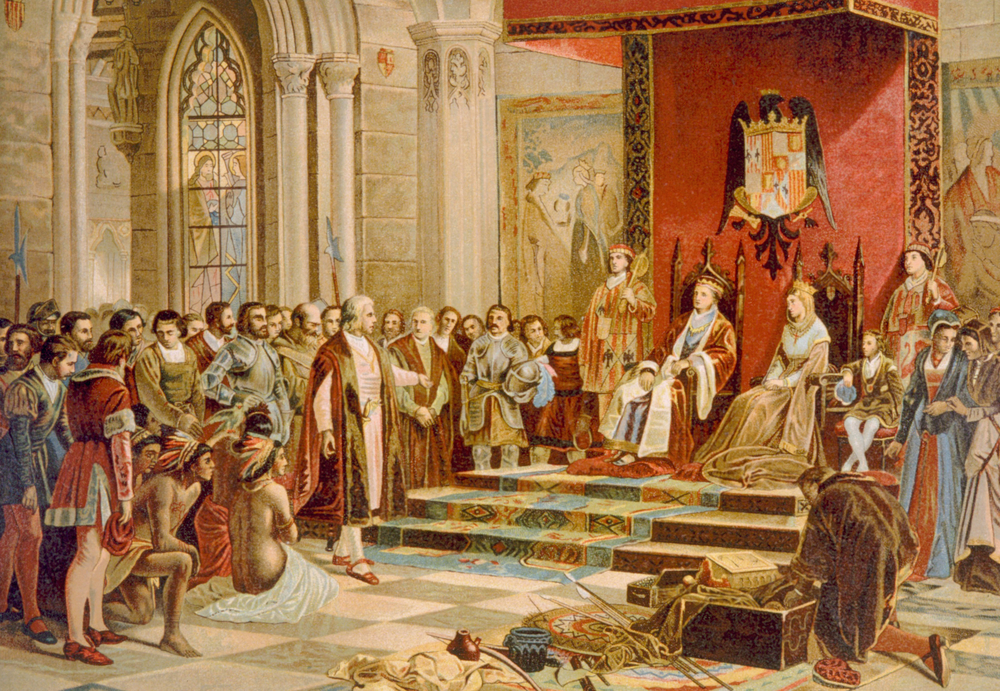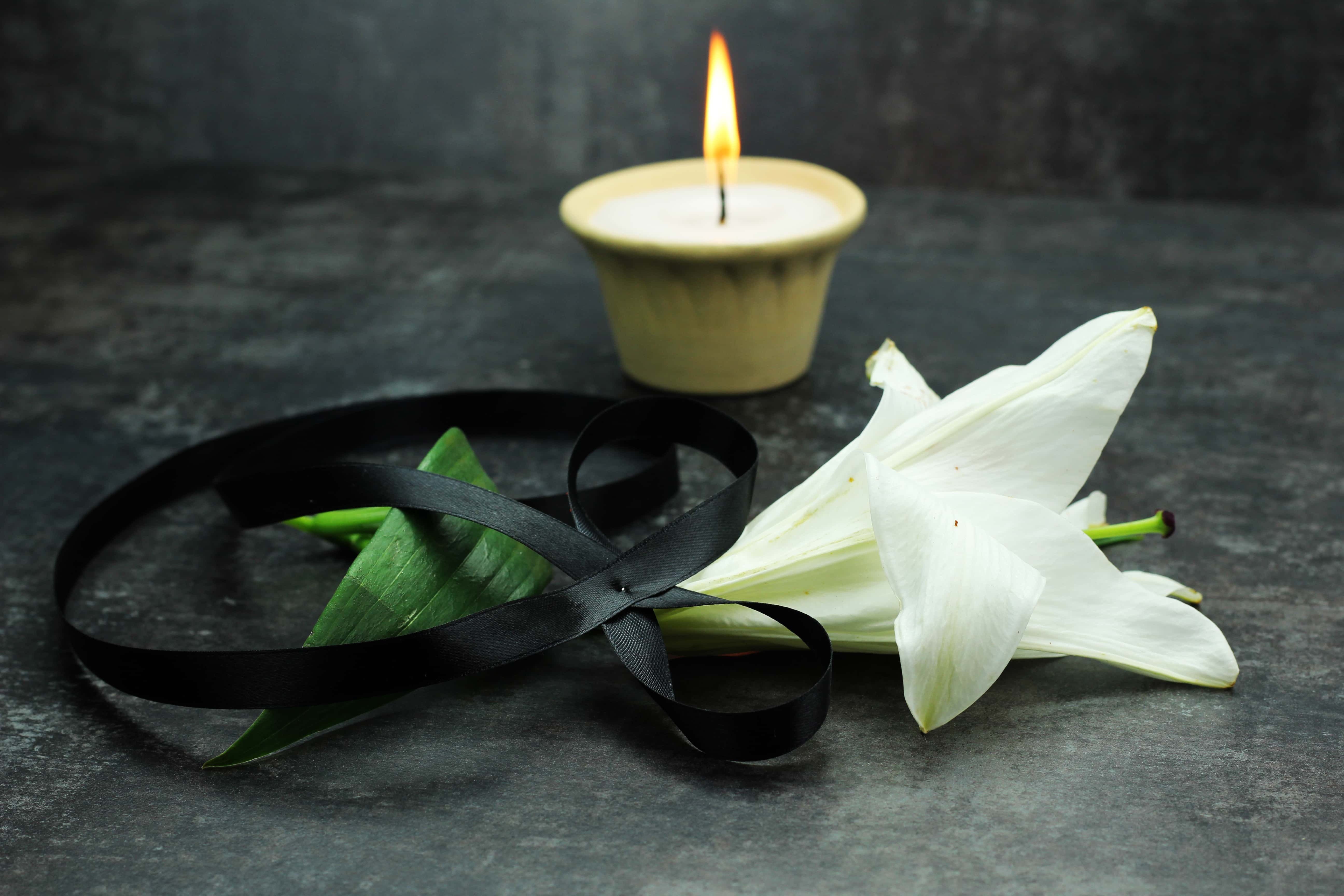Isabella of Aragon, the eldest daughter of the warrior queen Isabella I and King Ferdinand was born in a time of civil unrest in the kingdom. She grew up in the midst of a battle for the crown of Castile and ultimately became Queen Isabella of Portugal, before perishing at just 27 years old. Meet your new favorite tragic ruler: Queen Isabella of Portugal.
1. She Was The Fourth Of Her Name
When Queen Isabella of Portugal was born, Archbishop Carrillo totally failed in the originality department by christening her with the same name held by her great grandmother, her grandmother and her mother before her. Since her grandmother was still alive until a couple of years before the fourth Isabella’s passing, distinguishing them must have been confusing!

2. She Was Born Out of Wedlock
In marrying her husband King Ferdinand, Isabella’s mother broke a promise to her brother not to marry without his permission. He was furious at his sister and in his rage, he declared that not only did their marriage not count, the royal couple’s baby daughter was illegitimate. Now that’s no way for a princess’s reign to begin.
3. Her Birth Was Bad News
You’d think the birth of a royal heir would be cause for celebration, but not so in the case of Isabella. The royal couple needed a male heir to secure their claim to the Castilian throne. If there was no male heir, then it would be a lot harder for Isabella’s parents to hold onto power. First Isabella’s illegitimate, and now this? Sounds like a great start for a mother/daughter relationship...
4. She Wasn’t A Daddy’s Girl
Ferdinand didn't hate his daughter, but evidence suggests that he resented her, likely for being a girl. He chose to remain away from home more than he needed to, and with her mother seemingly unable to produce a male heir, Isabella grew up an only child. She was vulnerable and all but abandoned by her father—at least until a new ally arrived on the scene.
5. Her Birth Was Legitimized
Luckily for Isabella, one of her mother’s old family friends came along and made her life a lot easier. In 1472, when Isabella was only a toddler, Gonzalo Fernández de Córdoba came back into the picture and used his prominent position within the Vatican to give her family a powerful ally: The pope himself. With him on their side, everything in little Isabella’s life would change.
6. Her Position Improved
In an instant, Isabella went from a nobody to the most important young girl in the country. The Pope stepped in to legalize her parents’ previously unofficial marriage, which meant that suddenly Isabella wasn’t a shameful out-of-wedlock baby, but a royal princess. While she was still in diapers, she inched closer to the Castilian throne. In the world of Spanish royalty, things changed fast—and trust me when I say the drama over the throne was just beginning.
7. She Was Proclaimed Heiress
Isabella’s uncle Henry loved power but failed in one key area: Producing an heir. Unfortunately for him, his bedroom troubles were so notorious that he received the shady nickname “Henry the Impotent.” When he passed in 1474, he left no child to take over his crown, meaning that Isabella’s mother became the new Queen of Castile. She promptly declared her four-year-old Isabella to be her heiress.
8. She Lost Her Place
When young Isabella was nearly eight, her mother gave birth to the long-desired male heir, and the reaction to his birth couldn’t have been more different to the awkward silence that accompanied Isabella’s own. The Spaniards saw his arrival as a gift from heaven. The people held parades in his honor and flocked to the street to welcome him. Meanwhile, the baby boy’s birth shoved Isabella away from the crown—but that didn’t mean there wasn’t still a use for her...
9. She Was Unusually Educated
Giving her children a good education was of utmost importance to the queen, and she made sure that Isabella and her siblings studied the bible, the classics, and Latin. The girls also learned about the boring domestic skills that would make them good wives. By all accounts, young Isabella was the more obedient of the sisters, so she must have taken those lessons to heart. Unfortunately, she wouldn't have much time to put them into practice.

History's most fascinating stories and darkest secrets, delivered to your inbox daily.
10. She Spent Her Childhood In Battle
Spain was in conflict for most of Isabella’s childhood, but rather than making an effort to keep Isabella protected, her parents often took her on their violent campaigns against the Portuguese. For instance, she witnessed battle firsthand when she accompanied her mother into Baza Granada to accept their surrender. The queen may have been trying to teach Isabella about statecraft—but leading her daughter into battle zones would have terrifying consequences.

11. She Was Trapped in a Tower
When Isabella was a little girl, a bitter conflict was taking place between Spain and Portugal putting the princess in danger. While the king and queen went off to deal with the hostility, they left seven-year-old Princess Isabella behind in Segovia. The plan was for a courtier named Beatriz de Bobadilla to take care of Isabella and keep her safe. Unfortunately for little Isabella, that isn’t what happened.
12. She Was Caught in the Chaos
While the king and queen were away, Beatriz and her husband were supposed to keep the city running smoothly. Instead, everything dissolved into chaos. The citizens of Segovia apparently hated the idea of random courtiers running their town—and they rose up to voice their displeasure with a brutal act that would change Isabella’s life forever.
13. She Was Trapped In The Tower
The Segovians rose up against Isabella’s guardians in a violent revolt. They managed to take control of the city and saved an especially heinous punishment for little Isabella. They trapped the terrified seven-year-old princess in the gloomy tower of the Alcázar. For days on end, she stayed there, alone and afraid, as the crowd called out for blood down below.
14. Her Rescue Was Epic
As soon as the queen learned that her daughter was in peril, she rode back to Segovia and demanded that the protesting citizens move aside and allow her to enter. Like a true boss of history, this mighty mother rode into the city all by herself. Once inside Segovia, Queen Isabella single-handedly rescued her daughter from the tower. It was a happy end to a terrifying ordeal, but more danger was just around the corner.

15. She Was Part Of The Terms
The violent fight for the Castilian throne finally ended in 1481 with the signing of the Treaty of Alcaçovas—but there was a huge catch. As assurance that the queen would hold up her end of the deal, she had to send her eight-year-old daughter Princess Isabella to live in Portugal for three long years, separating her from her parents once again. Though they called her a visitor, that was far from the truth and she was actually a captive.
16. She Was A Royal Catch
Whoever married Isabella was going to get a pretty sweet deal. When she first signed up for Renaissance royalty’s version of Tinder, she was a blossoming 15-year-old girl with fair skin, strawberry blonde hair, and big grey-blue eyes. Plus, her mother dressed her to the nines all the time. Isabella was a total catch—but her marriage wouldn’t be a fairy tale romance. Not by a long shot.
17. Her Marriage Was Strategic
Being a girl, and the eldest daughter of a Queen didn’t afford Isabella the opportunity to marry for love. Her mother wanted all of her children to have a good chance of being happy, but in the world of Spanish royalty, there was always going to be strategy behind a wedding—and Isabella’s marriage was no different. She became betrothed to the heir to the Portuguese throne for a slew of decidedly unromantic reasons.
18. She Was A Chess Pawn
Here’s the least skeezy reasons for Isabella’s wedding to Afonso, Prince of Portugal. Not only would the alliance would give Isabella’s parents’ some much-needed back up to help defeat their enemies, it would also help create peace between Spain and Portugal. Now let’s get down to the dicier side of things: Isabella was basically a glorified prisoner.
As part of the marriage agreement, Isabella had to live in Portugal, not just to be close to her new husband—but so that they could keep an eye on her and almost certainly use her as a bargaining chip if Spain ever decided to strike.
19. She Didn’t Hate Him
Isabella’s future husband Afonso wasn’t exactly a stranger. The two first met when they were children and living together in Portugal under the care of Isabella’s aunt Beatriz. They got to like each other, and in 1490 when Isabella was 20 and Afonso was 15, they got married. But there was a twist when it came to the wedding: The groom didn’t show.
20. Her Groom Wasn’t Present
In Afonso’s defense, he didn’t mean to leave young Isabella stranded at the altar. Instead, his busy schedule apparently made squeezing in his own marriage impossible, so he sent a friend in his stead. Yes, Isabella technically married some strange guy who stood in for her husband. Back in the day, they called it marriage by proxy. In modern times, it’s called an instant deal-breaker.
21. She Had A Queen’s Welcome
In fairness to him, when Afonso and Isabella finally had a proper wedding the groom went all out. Portugal hosted weeks of celebrations for the new couple and the country buzzed with excitement over the new royal couple. One account even sad that the crowd went so wild at Isabella’s entrance that it felt like the earth itself was trembling.
22. She Fit Right In
Despite their match being politically motivated, Isabella and Afonso were fond of each other and over time, they fell in love. This was extremely rare for an arranged royal marriage, and Isabella made sure to enjoy her romance. She was a big hit with the Portuguese royal family, and even won over her notoriously cold father-in-law. But the good times wouldn’t last forever.
23. She Was A Hit At Court
Isabella was a bit of a 1400s theater kid. When she married Afonso and moved to Portugal, she brought previous knowledge of the country’s customs with her. She’d perform dances and routines so well that her in-laws often asked her to entertain the Portuguese royals at court and banquets. Everything seemed to be on track for a phenomenally successful marriage—then in an instant, Isabella lost it all.
24. Her Marriage Ended In Tragedy
Everything changed in July 1491 when Isabella’s husband went off with his father on an afternoon horseback ride. In a freak accident, his horse tripped and fell, throwing the prince to the ground and crushing him. Isabella and his mother prayed to save the prince, but their pleas were in vain. At just 16 years old, Afonso passed a few hours later. Poor Isabella was now a widow.
25. She Was Inconsolable
The entire kingdom grieved for Afonso, but none more than Isabella. She took the loss of her husband so hard that the family talked about it for generations. In her grief, Isabella went full emo. She cut off her long hair, wore a veil to shield her face from the world, and put on mourning clothes. She was so inconsolable that she didn’t change her outfit for forty long and presumably stinky days to punish her body. And that wasn’t the half of it.
26. His Parents Worried About Her
From the way she mourned, you’d think that Isabella was trying to join her husband. She stopped eating to the point of starvation, and only then did she agree to sip on broth. She became sick with fevers, spent her days in room lit by a single candle reading religious texts, and went to mass every single day. It’s a wonder that she survived at all.
27. Her In-Laws Tried To Help
Amazingly enough, Isabella’s actions weren’t out of line for customary grieving practices in Portugal, but she took it to extreme. Of course, Afonso’s parents also grieved their son, but they grew so concerned for their daughter-in-law’s survival that they had no choice but to interrupt their own mourning and tend to her. How'd they show their concern? With a very odd gesture.
28. She Accepted Little Comfort
In her grief, Isabella effectively regressed into an infantile state—so her in-laws acted accordingly. They moved the weeping widow into their own royal bedroom where they could keep a close eye on her. However, even this next-level surveillance didn’t improve Isabella's state. The young widow continued to wail. The only difference was that she now accepted a few “luxuries” like a thin blanket to keep warm.
29. She Searched For Answers
In her mourning, Isabella grew introspective, trying to figure out why the tragedy had occurred. She was particularly fixated on what she and the Portuguese people had done to make the lord unhappy enough to punish them this way. She convinced herself that they had displeased the heavens for allowing the expelled Spanish Jews to settle in Portugal. No one knows where she got the idea, but it would wreak havoc on the country in the years to come.
30. She Had to Go Home
Eventually, Isabella’s parents decided that it was time for her to come home, where they hoped they could help her recover. However, when she came home, she remained deeply religious. Isabella continued to starve and torment herself, swearing that she would never remarry. In her one normal action, she took up her old position as her mother’s assistant, but she wouldn’t stay that way for long.
31. They Humored Her For a While
Recognizing and respecting Isabella’s grief, her parents gave her a lot of leeway and didn’t force the issue of remarriage, but all that changed in 1495 with the passing of King Juan, Isabella’s ex-father-in-law. With his demise, Isabella reluctantly re-entered the political arena. This time, she wasn’t the blushing bride from just a few years ago, but a grieving widow.
32. She Had Another Prospect
Afonso’s sudden demise left his father without a legitimate heir and, seeing as how Afonso and Isabella hadn’t had any children, there wasn’t a royal grandbaby to receive the crown either. Instead, the Portuguese crown passed to a distant relative: The king’s cousin Manuel—and it just so happened that he had his eye on Isabella.
33. He Was So Into Her
A series of good luck, including inheriting the crown, earned Manuel the nickname Manuel the Fortunate (way better nickname than “Henry the Impotent;” good job Manuel). With his new throne, this already fortunate gent was about to hit the jackpot. You see, Manuel had always fancied Isabella, but he figured he had no shot at her because A) She was his nephew’s wife and B) She was a princess and he was more than a few steps away from the throne.
When both those things changed, Manuel decided to shoot his shot.
34. He Wanted Her Kingdom
Sure Manuel was hot for Isabella, but don’t fool yourself into thinking that this was a love match. He wanted to marry Isabella, largely because she held a rare and mighty power. Thanks to her family and her status as Afonso’s widow, she was second in line for not one but two thrones. This made her an extremely attractive choice for a royal bride.
35. She Refused Him
When Isabella said she’d never remarry, she meant it. Her parents tried to offer Manuel her younger sister Maria, but Manuel didn’t want anyone other than Isabella. He even threatened to go outside of the kingdom for a bride. Isabella’s parents tried to pressure her into ending her mourning and her religious rituals to marry him, but Isabella held steady. She completely and utterly refused.
36. She Was In A Test Of Wills
Isabella’s mother, the Queen of Castile, was so busy with other important matters in the kingdom that when Isabella refused Manuel she let it stand. However, marriages weren’t just for love and soon, dangerous circumstances forced the Queen’s hand. She had to fortify the Castilian border with Portugal—and the only way to do that was via another marriage between the kingdoms.
Manuel still only wanted to wed Isabella. Isabella dug in her heels and refused. Finally, it came down to a battle of wills between Isabella and her mother.
37. Her One Condition
Eventually, when push came to shove, the Queen Mother won. Isabella finally agreed to marry Manuel, but she had one chilling condition. Her new beau had to expel all Jews who were unwilling to convert to Christianity. Manuel, thrilled that fortune smiled on him yet again, readily agreed. There’s nothing like persecution to get you in the mood for a wedding!

38. She Wanted A Quiet Affair
Isabella wasn’t exactly excited about getting married, so if she was going to walk down the aisle, she wanted her wedding to be as low key as possible. Manuel, who would do pretty much anything to keep her from backing out, quickly agreed to have an austere ceremony that cut back on the usual pomp and circumstance. Unfortunately, as the dour couple prepared for their wedding, another tragedy occurred.
39. He Tried To Keep It From Her
Right before the wedding, Isabella’s brother Juan became seriously ill, and prospects for his recovery didn’t look good. In an effort to spare his new wife worry and/or grief at their wedding, Manuel asked that nobody tell her until after the ceremony. However, some historians believe that he had a much darker reason for not telling Isabella about her brother’s fate.
40. He Put Out A Gag Order
Manuel may have made everyone zip it about Isabella’s brother not out of concern, but good old ambition. He worried that his already-reluctant bride would use it as an excuse to delay the ceremony until after another of her trademark crazy mourning periods, and Manuel definitely didn’t want to wait to enjoy the powers he’d enjoy with Isabella by his side.
41. They Had A Meet Ugly
Here’s a bonus fact to get you creeped out by the upcoming nuptials between Queen Isabella of Portugal and her new boo Manuel. Their meet-cute was more of a meet-ugly. Manuel had been the one to travel with Isabella on her way into Portugal years ago—awkwardly en route to marry Manuel’s nephew. He fell for her immediately because getting a crush on your relative’s fiancée isn’t awkward at all.
42. She Was Back On Top
With her wedding, her brother’s demise, and sadly, the stillbirth of his shoulda-been heir, Isabella became the Princess of Asturias, the Queen of Portugal, and the first person in line for the throne of Castile. This meant that one day, Isabella (and Manuel by proxy) could control the Iberian Peninsula and all of Portugal and Spain’s massive foreign holdings.
43. She Did What She Had To
Despite Queen Isabella of Portugal really not being interested in marriage, she and Manuel seemed to get along well enough. Isabella became pregnant with their child in late 1497 and by August 23, 1498, she was in labor. Even though childbirth was an absolute nightmare back in the 1400s, Isabella’s experience would be as horrific as possible.
44. She Produced An Heir
After many painful hours in labor, Queen Isabella of Portugal managed to give birth to her little son. Though weak, she managed to name the boy Miguel. Sadly, she couldn’t muster up the strength to do much more than that. Isabella’s labor was so violent that it sadly ended the young mother’s life. At the time of her passing, Queen Isabella was just 27 years old.
45. Her Body Gave Out
Childbirth was never going to be fun, but why was Isabella’s labor in particular so awful? Historians believe they now know why. At the princess’s sad fate might go back to her first husband’s sudden passing. Isabella had reacted to Afonso’s demise by starving and harming herself so greatly that she became incredibly thin and weak. Because Manuel didn’t want to wait long in between Afonso’s passing and his new marriage to Isabella, she was probably extremely frail when she gave birth.
46. More Tragedy Came
Sadly, Isabella’s demise was just the beginning. She gave her life to give birth to the new Prince of Portugal, but even that wasn’t enough. The baby boy passed just two years after his mother and didn’t even make it to his third birthday.
47. Her Burial Was Quirky
When Queen Isabella of Portugal knew her time was coming to an end, she had one final quirky request. Despite being one of the most powerful women in the world, she didn’t want the burial of a queen or a princess. Instead, she asked that they dress and bury as a nun. Hmm...maybe a sign about what career she would have pursued if Manuel didn’t low-key force her to marry him?
48. Her Ex Betrayed Her
After Queen Isabella of Portugal passed during childbirth, her husband Manuel grieved her loss. However, he was still king and kings apparently had to be married to prominent noblewomen all the time, even if their wife had literally just kicked the bucket. Manuel tied the knot with a new lady just two years after Isabella’s death—and that’s far from the most scandalous part of his second marriage.
49. His New Bride Was Creepy
You’d think that Manuel had a thing for Castilian princess because, get this, his second bride was Isabella’s own sister Maria. But that’s not the whole story. The truth is somehow worse. Apparently, Manuel turned Maria down multiple times. Instead, it was Isabella’s own mom who was determined to make the match work. Look, I get that royal families always have messed up family trees, but this is a bridge too far.
50. Her Mother Outlived Her
Queen Isabella of Portugal lived a short, tragic life. Her mother, the other Queen Isabella, lived for almost twice as long and apparently, she never quite made peace with losing her beloved daughter. Shortly before the queen passed in 1504, she asked to relocate her daughter’s body to Granada so that mother and daughter could rest side by side, but sadly, it never happened.

























































